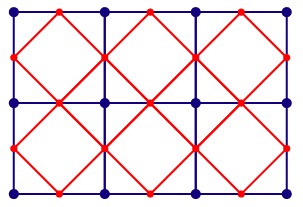|
Exercises for the second supervision
The first two exercises are new. The third through sixth exercises can
be found in the Study Guide:
Section 4A, Exercise 3
Section 4C, Exercise 3
Section 4D, Exercise 4
Section 5, Exercise 2
For your convenience the set of exercises is gathered
together below.
 [New]
The Doo-Sabin subdivision scheme is illustrated in SMEG, page 23, Figure 3. The Reif-Peters scheme
is illustrated in the diagram on the right. Reif-Peters uses a
different approach to Doo-Sabin: in it the new points are generated
halfway between existing points and connected up into a mesh as
illustrated in the diagram on the right (blue: original mesh; red: new
mesh). Note that (i) the existing points do not form part of the new
mesh and (ii) each new point's position is simply the average of the
positions of the two existing points at either end of the
corresponding line segment. [New]
The Doo-Sabin subdivision scheme is illustrated in SMEG, page 23, Figure 3. The Reif-Peters scheme
is illustrated in the diagram on the right. Reif-Peters uses a
different approach to Doo-Sabin: in it the new points are generated
halfway between existing points and connected up into a mesh as
illustrated in the diagram on the right (blue: original mesh; red: new
mesh). Note that (i) the existing points do not form part of the new
mesh and (ii) each new point's position is simply the average of the
positions of the two existing points at either end of the
corresponding line segment.
(a) Doing the Reif-Peters
subdivision twice produces a mesh which looks similar to that produced
by doing the Doo-Sabin subdivision once (SMEG, page 23, Figure
3(left)). You can treat two steps of Reif-Peters as if it were a
single step of a Doo-Sabin-like subdivision scheme. Calculate the
weights on the original points for each new point after two steps of
Reif-Peters (i.e. work out what numbers replace those in SMEG Figure
3(right) for the Reif-Peters two step scheme). [2 marks]
(b)For the Reif-Peters one step scheme, explain what happens around
extraordinary vertices and what happens around extraordinary polygons,
giving examples. [2 marks]- New The univariate binary C2 6-point subdivision scheme
interpolates the original points and generates a new point between
every existing pair by:
P2in+1=Pin
P2i+1n+1=
a0Pi-2n +
a1Pi-1n +
a2Pin +
a3Pi+1n +
a4Pi+2n +
a5Pi+3n
The univariate ternary C2 4-point subdivision scheme interpolates the original points and generates two new points between every exisiting pair by:
P3in+1=Pin
P3i+1n+1=
c0Pi-1n +
c1Pin +
c2Pi+1n +
c3Pi+2n
P3i+2n+1=
c3Pi-1n +
c2Pin +
c1Pi+1n +
c0Pi+2n
(a) Given an initial set (n=0) with M points, how many floating point
operations are required in the binary and ternary cases to create the
complete set of points for n=1? For both binary and ternary, consider
both the case of an open curve and the case of a closed curve. (Note:
in a closed curve the two ends of the curve join up and where we need
points which fall off the end of the sequence of points we can simply
loop round the indices by saying
Pin=Pi+Mn.) [4
marks]
(b) Both methods produce a C2 interpolating limit curve. We want to
compare the methods by producing refined sets of control points using
each of the two methods and compare the number of calculations
involved to see which is more efficient. Obviously we cannot get
exactly the same number of points in the refined sets (why not?). So,
say we produce a refined set of points with (roughly) 8 times (binary) or 9
times (ternary) as many points as in the original, then which of the
two methods is more efficient in terms of floating point operations?
[2 marks]
(c) What factors other than number of floating point operations will
affect execution speed? How does execution speed depend on M? [3
marks]
(d) Now, distribute the original set of points evenly along the
x-axis, with Pi0=(i,0) for all i, except
P00=(0,1). In the limit, most of the limit curve
will lie exactly on the x-axis. For both the binary and the ternary
scheme, what is the range of values of x for which the limit curve
does not lie on the x-axis? Assume that aj≠0, j ∈
{0,1,2,3,4,5} and cj≠0, j ∈ {0,1,2,3}. (Note: the
point of doing this is that it tells you how much of the limit curve
is affected if you move a single original point.) [4 marks]
- [4A/3] For each of the following categories list five
real-world objects which could be represented by the primitives in the
category.
- The ray-tracing primitives in Part 2A
- Extrusions
- Surfaces of revolution
- General sweeps (generalised cylinders) which cannot be represented by just an extrusion or a surface of revolution.
[4 marks]
- [4C/3] List the three ways of combining objects using
constructive solid geometry (CSG). Describe how an object built using
CSG can be represented using a binary tree. Given the intersection
points of a ray with each primitive in the tree, explain how these
points are passed up the tree by each type of combination node to
produce a list of intersection points for the whole CSG object. [8
marks]
- [4D/4] The marching squares algorithm is a
two-dimensional version of marching cubes, where you generate line
segments in 2D rather than triangles in 3D. It could be used, for
example, where you have a regular grid of height values and want to
draw contours of constant height. Sketch an implementation of this
two-dimensional marching squares algorithm. [6 marks]
- [5/2] Explain what a form factor is, in radiosity.
Outline an implementable method of calculating form factors. [5
marks]
This exercise set is marked out of 40. This should take 72
minutes in an examination.
|